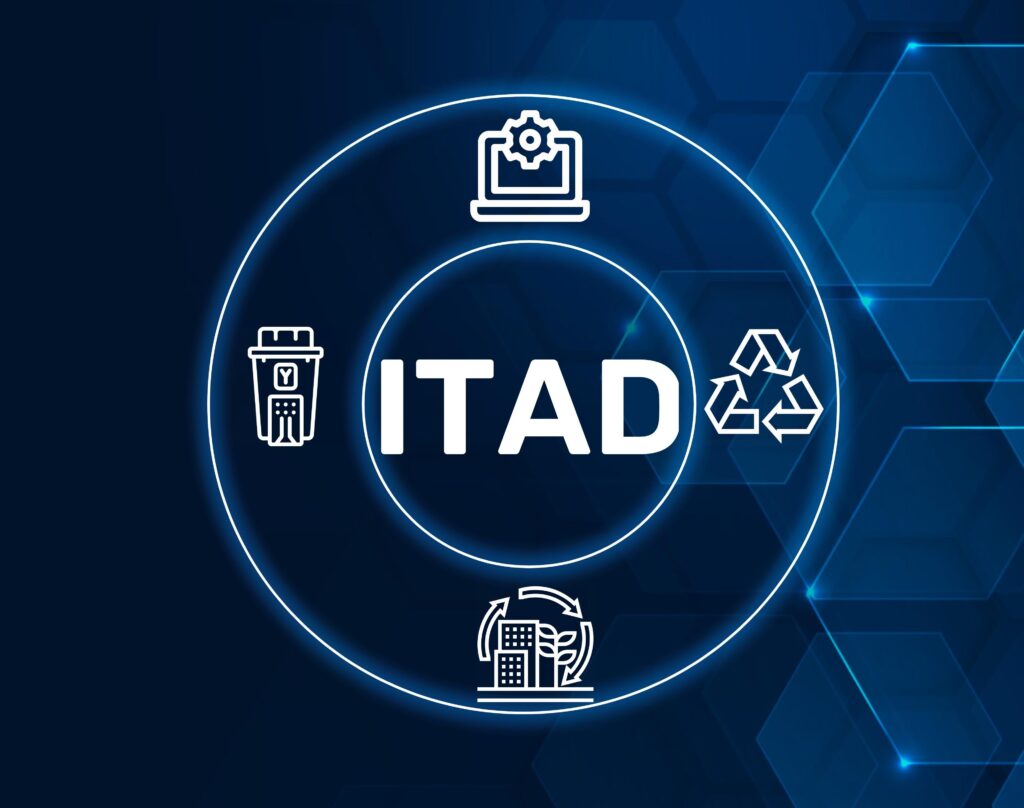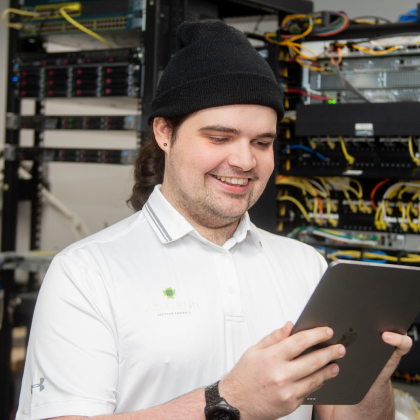Georgia’s Data Center Boom and the Circular Economy
In the past year, Georgia had the second-largest investments of data centers in the country, second only to Northern Virginia. Major projects from Amazon Web Services, Meta, and a growing number of mid-sized firms are fueling Georgia’s continued growth as demand for cloud computing, AI infrastructure, and data analytics accelerates.
This growth brings significant benefits to the economy, but it also adds pressure from higher energy use, faster hardware turnover, and increased e-waste.
To understand what this means for Georgia’s economic future, we spoke with Chris Clark, President and CEO of the Georgia Chamber. His insights, combined with our perspective on IT asset disposition (ITAD), shape this article.
We’ll explore Georgia’s data center growth, the challenges it creates, and how ITAD can support sustainable expansion.
Key Takeaways
- Georgia has become one of the fastest-growing data center markets in the country, with Metro Atlanta leading the nation in net absorption in 2024.
- This rapid expansion fuels jobs and tax revenue, while leveraging Georgia’s business-friendly climate, skilled workforce, and reliable infrastructure to attract global technology investment.
- Growth brings sustainability challenges, including rising power and water demand, faster hardware refresh cycles, and an e-waste problem without a clear statewide recycling policy.
- Circular economy practices provide solutions, helping data centers reduce e-waste by reusing equipment, recovering value by reselling hardware and extending its lifecycle, and recycling responsibly.
- IT asset disposition (ITAD) is a process that protects data, unlocks hardware value, ensures compliance, and makes Georgia’s data center boom both profitable and more sustainable.
Georgia’s Growing Data Center Economy
In 2024, Metro-Atlanta recorded the highest net absorption in the U.S. data center market at 705.8 MW, while construction activity increased 76 percent from the same period in 2023. Across Georgia, the state already hosts nearly 160 data-center facilities, with at least 11 additional projects planned or under development.
In our interview with Clark, he stated that data centers have become a part of Georgia’s infrastructure, saying, “Data centers are like infrastructure — just like a road, hospital, or bridge… As more companies and individuals need more computing power, more cloud storage, and more access, that demand will continue to multiply, and our hope is that we can keep pace in Georgia by bringing in the firms that will operate here for a very long time and provide that service.”
Amazon Web Services (AWS) leaders say this scale of demand would have been hard to imagine just a few years ago.
“If you go back to 2006, I don’t think anyone understood what the size of this industry was going to be,” said Kerry Person, vice president of data center planning and delivery at Amazon Web Services. “Demand for data center capacity has gone up substantially as we learn more about the potential for AI.”
Major Projects in Georgia’s Data Center Market
Here are some of the largest projects now shaping Georgia’s data center market:
| Project Name | Location | Estimated Value | Scope |
| Project Sail | Coweta County | $17 billion | 9 buildings, 4.34M sq. ft. campus |
| Project West | Troup County | $10 billion | 6, 250 sq. ft buildings, 600 MW capacity, ~600 jobs |
| T5 20-Building Campus | Georgia (various) | ~$16 billion | 1.2 GW power draw, largest T5 project locally |
| AWS Butts & Douglas | Butts & Douglas Co. | $11 billion | AI data centers, 550 skilled jobs planned |
| xAI / X Atlanta Facility | Atlanta | $700 million in hardware | ~12,448 GPUs for AI compute operations |
Georgia’s Local and Statewide Advantages
“The e-waste component is an interesting conversation not many of us had a couple years ago,” said Clark. “But today, I think whether you’re in manufacturing, you’re in distribution, if you’re using all those technologies, all those resources, and they have a finite life on them. And the fact is that we’re going to have to upgrade and update…all those different AI techs that are out there — what are they going to do when they need to dispose them? What’s that process?”
His words reflect how data centers are changing both local communities and Georgia’s economy, introducing new conversations around e-waste and sustainability, while weighing the economic gains. In Fayette County, for example, QTS’s $1B campus is expected to become the county’s largest taxpayer within ten years, bringing in about $40M a year.
Georgia is also attractive for global companies because of its strong fiber networks, skilled workers, low business costs, and fewer natural disaster risks compared to coastal states.
Tax incentives, such as the state’s sales and use tax exemption for data center equipment, make it even more appealing for large technology projects.
The Sustainability Challenge in Georgia’s Tech Growth
Georgia’s rise as a data center hub brings big opportunities, but it also creates new pressures. Rapid growth means higher power use, faster hardware upgrades, and more e-waste. Without planning, these issues could cut into the long-term benefits.
Rising Energy Demand
Data centers use 10 to 50 times more power than a typical commercial building, and hyperscale facilities can draw more than 100 MW of power, much larger than a typical office complex. With nearly 160 facilities already running and more being built, Georgia Power expects electricity demand to rise 67 percent in the next 25 years.
To prepare, the utility has proposed major investments in nuclear plants, hydroelectric upgrades, and stronger transmission systems.
Rising Water Use
Data centers also need large amounts of water for cooling. One study estimates that AI-driven data centers could use 1.7 trillion gallons of water worldwide by 2027. In Georgia, where many facilities are near Atlanta, this will put more pressure on local water supplies.
Organizations like the Georgia Water Coalition are calling for more transparency in how much water data centers use, and companies are exploring technologies like closed-loop cooling to reduce water consumption.
The Growing E-Waste Problem
AI and cloud servers are being refreshed and replaced at a fast pace as technology advances, shortening refresh cycles for GPUs and other high-performance hardware. This means large amounts of retired hardware are piling up each year.
The risks include:
- Improperly handled equipment can expose sensitive data
- Retired hardware can end up idle or scrapped instead of reused
- Missed opportunities to recover and repurpose valuable materials — sometimes worth millions in returned value.
Chris Clark noted that just a few years ago, e-waste was rarely discussed in business circles.
“The e-waste component is an interesting conversation not many of us had a couple years ago… companies are going to be looking for partners to help them find those sustainable solutions,” he said.
Lack of Policy Direction
Unlike automotive recycling, Georgia lacks a comprehensive statewide policy to guide or encourage responsible IT recycling. Clark pointed out that most of the work is left to private companies. This creates an opportunity for Georgia businesses to set the standard and show leadership in sustainability.
Environmental Impact
As discussed, data centers require large amounts of electricity that puts pressure on the environment, much of which still comes from gas and coal plants. As more centers are built, utilities are planning new gas plants and keeping older coal plants running longer.
“Each new data center could lead to greenhouse gas emissions equivalent to a small town,” said Marilyn Brown, Regents’ and Brook Byers Professor of Sustainable Systems at Georgia Tech.
Applying the Circular Economy in Georgia’s Data Centers
Running data centers in Georgia means dealing with faster hardware turnover. AI workloads shorten refresh cycles, so equipment is retired sooner.
This leaves operators with growing stacks of used servers and storage gear that take up space, carry data risks, and lose value if not managed the right way.
The circular economy gives a clear way to handle this problem. It focuses on using equipment longer, recovering value, and reducing waste. Applied to data centers, the model looks like this:
- Reduce: Plan capacity smarter to avoid overbuying. Cut costs and prevent waste before it starts.
- Reuse/Refurbish: Repair or upgrade GPUs, servers, and other hardware to extend their lifecycle.
- Remarket: Sell retired equipment into secondary markets to help fund a future upgrade.
- Recycle: Partner with a certified ITAD provider for assets that need to be securely recycled or remarketed.
- Repurchase: Source affordable, reliable hardware from trusted secondary markets instead of always buying new.
Each step helps data centers cut costs, reduce waste, and make sure equipment is handled responsibly.
Chris Clark pointed out that companies will need help to do this.
“Companies are going to be looking for partners to help them find those sustainable solutions.”
That partner role can be filled by IT asset disposition (ITAD) companies. Done right, ITAD is a secure decommissioning process and makes sure every piece of hardware is either reused, resold, or recycled in line with sustainability goals. For operators racing to scale in Georgia, it is a sustainable way to keep growth responsible, compliant, and value-driven through asset recovery.
How IT Asset Disposition (ITAD) Supports Growth Responsibly

Circular economy principles are useful, but data center operators also need a process they can apply day-to-day. That’s where IT asset disposition (ITAD) and IT Asset Management (ITAM) comes in.
Here’s how it helps:
Secure Decommissioning and Data Protection
ITAD makes sure every server, storage system, and network device is fully wiped. This prevents data exposure. Providers use certified erasure tools, document each step with a full chain of custody, and track assets so the process is secure and audit-ready.
Value Recovery from Retired Equipment
Retired hardware still has value. ITAD helps companies refurbish, resell, or remarket devices to recover money. This extra revenue can offset the cost of upgrades, which is especially useful when refresh cycles are frequent.
Compliance and Environmental Responsibility
Secure data eradication is not optional. ITAD providers follow strict recycling standards to keep toxic materials out of landfills. They also provide records that prove compliance and support your sustainability goals. Inteleca, for example, is R2v3 certified, and we follow strict guidelines and policies to ensure secure data eradication and compliance.
Reducing Operational Overhead
Old equipment takes up space and adds hidden costs. ITAD removes it in a structured way, which reduces clutter, lowers logistics costs, and avoids the risks of ad hoc disposal.
Bottom Line
Clark sees Georgia’s future as competitive and diversified. He points to the state’s business climate, infrastructure, and university system as strengths that will help it grow into one of the largest state economies in the coming decades.
That future depends on more than investment. Stewardship has long been part of Georgia’s business culture, and sustainability is now a key way the state can lead. For data centers, that means planning for the full lifecycle of high-performance hardware, from GPUs and servers to networking equipment, to ensure growth remains both compliant, responsible and more sustainable.
At Inteleca, we support this work by helping Georgia companies retire IT hardware securely, recover value, and recycle responsibly. By making IT asset disposition part of every project, data centers can grow with confidence and keep sustainability at the center. Contact us today to learn more.



